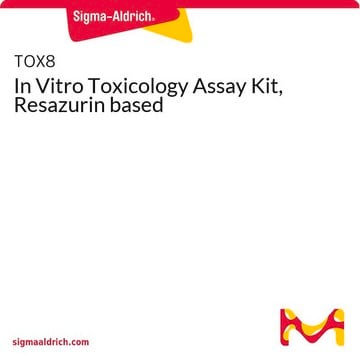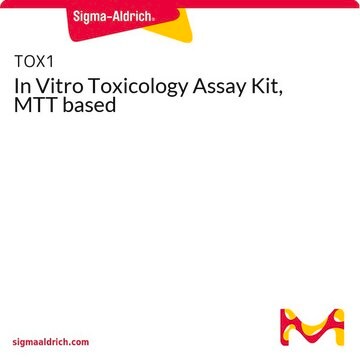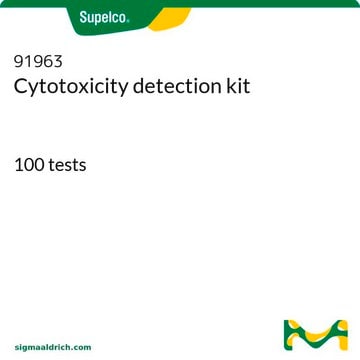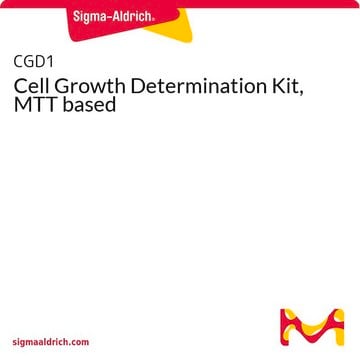TOX4
In Vitro Toxicology Assay Kit, Neutral Red based
Synonym(s):
NR uptake assay, Neutral red assay
Sign Into View Organizational & Contract Pricing
All Photos(1)
About This Item
UNSPSC Code:
12352207
NACRES:
NA.84
Recommended Products
form
liquid
usage
kit sufficient for 1,000 tests
packaging
pkg of 1 kit
storage condition
dry at room temperature
λmax
540 nm
application(s)
cell analysis
detection
detection method
colorimetric
storage temp.
2-8°C
General description
For spectrophotometric measurement of viable cells. Absorbance of converted dye is measured at a wavelength of 540 nm.
Application
In Vitro Toxicology Assay Kit, Neutral Red based has been used:
- to measure the lysosomal enzyme activity in HB8902 cells
- to study the cell viability of human alveolar epithelial cells
- to study the cell viability in fibroblasts
Biochem/physiol Actions
Neutral red (NR) is a red dye that accumulates in the lysosome by actively transferring across the cell membranes. The dye is extracted and the uptake is quantitated by spectroscopy. The NR uptake assay is the most commonly used cytotoxicity test. It is widely applicable in environmental and biomedical studies to estimate the number of viable cells in culture. The NR dye in vitro tissue culture studies is used in assessing viral cytopathogenicity and detection of toxic compounds.
Signal Word
Danger
Hazard Statements
Precautionary Statements
Hazard Classifications
Carc. 1B - Flam. Liq. 3 - Skin Sens. 1
Storage Class Code
3 - Flammable liquids
WGK
WGK 3
Flash Point(F)
73.4 °F
Flash Point(C)
23 °C
Certificates of Analysis (COA)
Search for Certificates of Analysis (COA) by entering the products Lot/Batch Number. Lot and Batch Numbers can be found on a product’s label following the words ‘Lot’ or ‘Batch’.
Already Own This Product?
Find documentation for the products that you have recently purchased in the Document Library.
Customers Also Viewed
An improved colorimetric assay for tumor necrosis factor using WEHI 164 cells cultured on novel microtiter plates.
C D Morgan et al.
Journal of immunological methods, 145(1-2), 259-262 (1991-12-15)
Michael Volkmar et al.
The EMBO journal, 31(6), 1405-1426 (2012-02-02)
In addition to genetic predisposition, environmental and lifestyle factors contribute to the pathogenesis of type 2 diabetes (T2D). Epigenetic changes may provide the link for translating environmental exposures into pathological mechanisms. In this study, we performed the first comprehensive DNA
Adam L Nathan et al.
Journal of medical devices, 11(1), 0110091-110099 (2017-02-10)
Highly porous, open-celled shape memory polymer (SMP) foams are being developed for a number of vascular occlusion devices. Applications include abdominal aortic and neurovascular aneurysm or peripheral vascular occlusion. A major concern with implanting these high surface area materials in
Thorsten M Seyler et al.
Arthroscopy : the journal of arthroscopic & related surgery : official publication of the Arthroscopy Association of North America and the International Arthroscopy Association, 33(2), 374-386 (2016-10-04)
To evaluate the biological, immunological, and biomechanical properties of a scaffold derived by architectural modification of a fresh-frozen porcine patella tendon using a decellularization protocol that combines physical, chemical, and enzymatic modalities. Porcine patellar tendons were processed using a decellularization
Simonetta Palleschi et al.
Chemosphere, 196, 35-44 (2018-01-01)
Fine airborne particulate matter (PM2.5) has been repeatedly associated with adverse health effects in humans. The PM2.5 soluble fraction, and soluble metals in particular, are thought to cause lung damage. Literature data, however, are not consistent and the role of
Our team of scientists has experience in all areas of research including Life Science, Material Science, Chemical Synthesis, Chromatography, Analytical and many others.
Contact Technical Service










